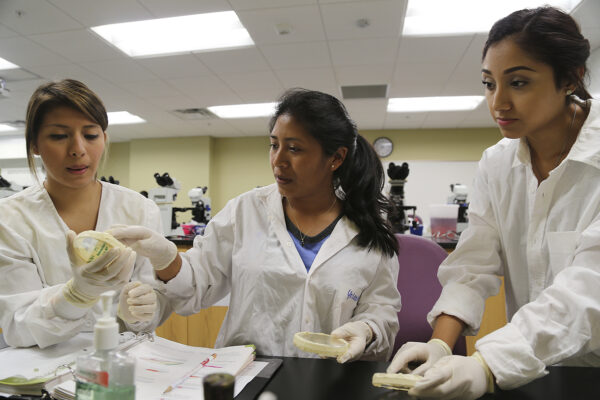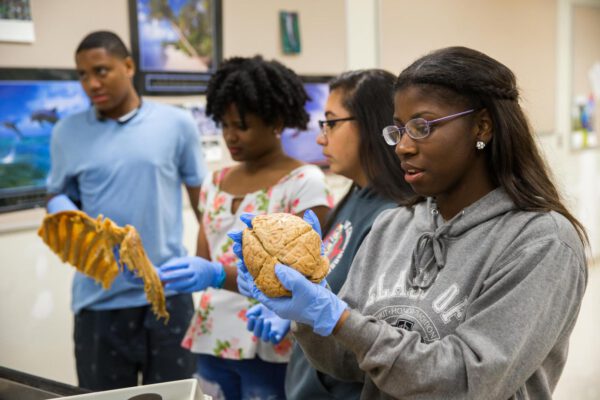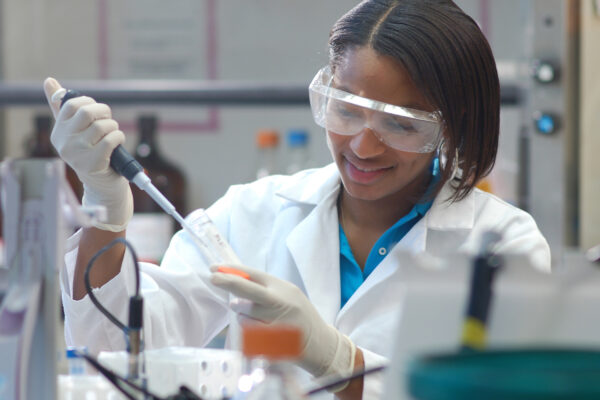By Kimberly A. Griffin
This post is the first in a series on campus climate and STEM success. ACE is partnering with the National Center for Institutional Diversity at University of Michigan on the series.
National and private organizations have invested millions of dollars in science diversity programs designed to shift patterns of representation in science, technology, engineering, and math—the so-called STEM fields—in and beyond college. However, minoritized* populations continue to be underrepresented in STEM disciplines. According to the National Center for Science and Engineering Statics, while over a third of black, Latino, and Native American students enter college with an interest in studying STEM, only 16 percent go on to obtain bachelor’s degrees in these fields.
Our limited progress may be rooted in how we are viewing and approaching the problem. Thought leaders, policymakers, and practitioners have engaged in two largely separate conversations as they have tried to increase STEM diversity. One conversation has focused specifically on the culture within these disciplines, noting how exclusionary norms and values translate to an unwelcoming environment. The other conversation has focused on college campuses more broadly, unpacking how inconsistent institutional commitments to diversity, acts of discrimination, and encounters with microaggressions in academic and non-academic spaces translate to hostile climates for women and men of color. We must attend to both STEM culture and institutional climate to cultivate more inclusive learning environments and increase diversity.
Understanding the Influence of STEM Disciplinary Culture
There are a set of norms and values that predominate science departments and programs, creating a unique culture in STEM fields. While there are some distinctions by discipline, scientists generally value objectivity and strive to make determinations about universal truths through experimentation and research. Within the culture, “scientist” and “academic” are the most valued identities; identities like “woman” or “person of color” are viewed as inconsequential in the search for truth and rarely, if ever, acknowledged or celebrated.
The likelihood of success in science is increased when students understand and adopt these norms and values. Creating opportunities for students to not only develop content knowledge but also to have hands-on experiences and feel a sense of belonging and identity as scientists seem to be particularly important. For example, students from underrepresented minority backgrounds, and women of color specifically, are more likely to be retained in science and engineering programs if they have opportunities to discuss and deeply engage STEM course content with peers, participate in undergraduate research, and join science clubs and organizations. Similarly, programs successful in recruiting and retaining women in science note the importance of opportunities to develop deeper understandings and connections to science through living and learning programs, broad mentoring, and opportunities to work closely with faculty in hands-on science experiences.
However, while socializing students into the culture of science can translate to increased representation of minoritized populations, continued investment in and avoidance of a critical assessment of science culture can intensify exclusion in multiple ways. First, scientific norms shape the perceptions of faculty, who are the gatekeepers that identify and train the next generation of scientists. The often-unconscious messages we are sent about what scientists look like, value, and do can form the foundation for biases, leading faculty to miss the talent and potential women and men of color bring to the laboratory. Second, the discomfort many faculty feel in recognizing their students’ identities outside of “scientist” leaves them more vulnerable to perpetuating stereotypes and assumptions about minoritized students’ capabilities. Finally, science norms may be in conflict with the goals, values, and needs many women and men of color articulate, leading them to feel like they do not or cannot fit in science spaces. For example, students from minoritized backgrounds may be particularly invested in doing work that addresses persistent social problems or serves their communities and diversifies higher education, but may not see academic science as a way to reach these goals given the culture’s emphasis on pure research and laboratory work.

Understanding the Influence of Campus Climate
Somewhat separate from the discourse on diversity and inclusion in STEM, the experiences and outcomes of minoritized college students are influenced by campus climate, or the attitudes, beliefs, behaviors, and perceptions of community members (including faculty, students, administrators, and staff) as they navigate issues of difference. Early work on climate focused on the experiences of women, noting how persistent encounters with stereotypes rooted in sexist beliefs, harassment, and marginalization translated to diminished quality in their educational experiences, leaving women to perceive the climate as more “chilly” than their male classmates. Students of color generally, and black students in particular, rate the campus climates as more hostile than their peers, and women are more likely to perceive a negative racial climate than men.
Decades of research suggest that more negative climate experiences translate to lower rates of academic achievement, retention, and success, and can have a particularly strong impact on the outcomes of students from minoritized populations. Research shows that perceptions of climate were significantly related to black, Latina/o/x, Native American, and white students’ institutional commitments, a key factor in retention. Other work shows that negative perceptions of climate were related to lower rates of on-time degree completion, an effect that was independent of satisfaction with campus life and exposure to stereotype threat (the perceived burden to perform because of social stereotypes about one’s abilities). Those who experience more positive campus climates are more engaged in academic activities (e.g., meeting with faculty, engaging in study groups), which are positively related to degree completion. However, given that minoritized students are less likely to perceive the climate positively, they are less likely to engage in these high-impact activities.
Aligning Discourses and Moving Forward: Campus Climate and STEM
We must pay close attention to how STEM students are experiencing both academic and non-academic spaces to facilitate achievement and persistence in these fields. An inclusive campus climate may mean that a student feels a sense of belonging institution-wide, but if they feel a lack of fit and alignment with the culture of STEM, they still will be less likely to complete a science degree. Further, science students live and learn in the larger campus community and must feel welcome and supported to stay at the institution and in their field.
While often discussed separately, the challenges minoritized students face within STEM programs can converge with their broader experiences on predominantly white campuses and can have an aggregative effect on their success. I believe these four recommendations can help refocus our efforts to address both the culture in STEM and climate of institutions to foster diversity and inclusion in science:
- Educate yourself. Understand what campus climate is and the student challenges that reach beyond the science classroom or laboratory, even as we focus on retaining students in STEM fields.
- Critically reconsider the culture of science and problematize values that we have considered “normal.” Center the experiences of marginalized students, understanding how they may not fit within traditional definitions of what makes a “good scientist.” Create new strategies to recognize and support the development of science talent, knowing this will likely benefit all students.
- Develop holistic initiatives that support students in and outside of STEM disciplines. Rather than developing more programs, develop collaborations and innovative campus partnerships that better integrate the work being done in and outside of the discipline.
- Acknowledge that faculty transmit science norms and identify the next generation of scientists. It is important to engender faculty buy-in and support of existing and new initiatives to promote inclusion with appropriate instruction, guidance, and incentives.
To promote social justice in the academy and reap the benefits associated with increased diversity in the STEM workforce, higher education institutions and leaders must be willing to take ownership for their roles in expanding access and success for all populations. A critical examination of how minoritized students’ experiences are simultaneously rooted in STEM disciplinary norms and broader campus climates creates new opportunities to develop innovative interventions that may make greater progress in addressing persistent barriers to retention and success. Promoting students’ sense of belonging and validating their identities in and outside of science classrooms holds great promise for promoting more equitable outcomes for all and hastening our progress towards a STEM community of scholars that more closely resembles the diversity of our nation.
*“Minority” speaks to numerical representation. The term “minoritized” acknowledges how social constructs like race, gender, ethnicity, religion, and sexual identity influence power dynamics and exposure to oppression. For more, please see https://www.theodysseyonline.com/minority-vs-minoritize.
If you have any questions or comments about this blog post, please contact us.


